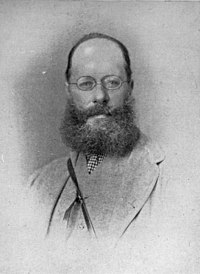Queer Places:
Bowman's Lodge, Bowman's Mews, London N7 6DA, UK
151 Grays Inn Rd, Holborn, London WC1X 8UB, UK
124 Albany St, London NW1 4EL, UK
61 Albany St, London NW1 4BT, UK
Southampton Row, Holborn, London WC1B 5HA, UK
27 Duke St, Marylebone, London W1U 1LE, UK
17 Stratford Pl, London W1C 2JR, UK
30 Seymour St, Marylebone, London W1H 7JB, UK
San Remo Cemetery San Remo, Provincia di Imperia, Liguria, Italy
 Edward Lear (12 May 1812[1][2]
– 29 January 1888) was an English artist, illustrator, musician, author and
poet, and is known now mostly for his literary nonsense in poetry and prose
and especially his limericks, a form he popularised. Many of the characters in
Lear's limericks and nonsense verses (and accompanying sketches) are
self-portraits.
Edward Lear (12 May 1812[1][2]
– 29 January 1888) was an English artist, illustrator, musician, author and
poet, and is known now mostly for his literary nonsense in poetry and prose
and especially his limericks, a form he popularised. Many of the characters in
Lear's limericks and nonsense verses (and accompanying sketches) are
self-portraits.
Lear's principal areas of
work as an artist were threefold: as a draughtsman employed to illustrate
birds and animals; making coloured drawings during his journeys, which he
reworked later, sometimes as plates for his travel books; as a (minor)
illustrator of Alfred, Lord Tennyson's poems. As an author, he is known
principally for his popular nonsense collections of poems, songs, short
stories, botanical drawings, recipes, and alphabets. He also composed and
published twelve musical settings of Tennyson's poetry.
Lear's most fervent and painful friendship was with
Franklin Lushington. He
met the young barrister in Malta in 1849 and then toured southern Greece with
him. Lear developed an infatuation for him that Lushington did not wholly
reciprocate. Although they remained friends for almost forty years, until
Lear's death, the disparity of their feelings constantly tormented Lear.
Indeed, Lear's attempts at male companionship were not always successful; the
very intensity of Lear's affections may have doomed these relationships.[14]
Edward Lear’s papers seem to have been selectively destroyed after his death
by the man for whom Lear had harboured a ‘thwarted, frustrated, impossible
love’.
The closest he came to marriage was two proposals, both to the same woman
46 years his junior, which were not accepted. For companions he relied instead
on friends and correspondents, and especially, during later life, on his
Albanian Souliote chef, Giorgis, a faithful friend and, as Lear complained, a
thoroughly unsatisfactory chef.[15]
Another trusted companion in San Remo was his cat, Foss, who died in 1886 and
was buried with some ceremony in a garden at Villa Tennyson.
Lear travelled widely throughout his life and eventually settled in San
Remo, on his beloved Mediterranean coast, in the 1870s, at a villa he named
"Villa Tennyson."
Lear was known to introduce himself with a long pseudonym: "Mr Abebika
kratoponoko Prizzikalo Kattefello Ablegorabalus Ableborinto phashyph" or
"Chakonoton the Cozovex Dossi Fossi Sini Tomentilla Coronilla Polentilla
Battledore & Shuttlecock Derry down Derry Dumps" which he based on
Aldiborontiphoskyphorniostikos.[16]
After a long decline in his health, Lear died at his villa in 1888 of heart
disease, from which he had suffered since at least 1870. Lear's funeral was
said to be a sad, lonely affair by the wife of Dr. Hassall, Lear's physician,
none of Lear's many lifelong friends being able to attend.[17]
Lear is buried in the Cemetery Foce in San Remo. On his headstone are
inscribed these lines about Mount Tomohrit (in Albania) from Tennyson's poem
To E.L. [Edward Lear], On His Travels in Greece:
- all things
fair.
- With such a pencil, such a pen.
- You shadow'd forth to distant men,
- I read and felt that I was there.[18]
The centenary of his death was marked in Britain with a set of Royal Mail
stamps in 1988 and an exhibition at the Royal Academy. Lear's birthplace area
is now marked with a plaque at Bowman's Mews, Islington, in London, and his
bicentenary during 2012 was celebrated with a variety of events, exhibitions
and lectures in venues across the world including an International Owl and
Pussycat Day on his birth anniversary.[19]
My published books:


BACK TO HOME PAGE

- https://en.wikipedia.org/wiki/Edward_Lear
- Robb, Graham. Strangers: Homosexual Love in the Nineteenth Century .
Pan Macmillan. Edizione del Kindle.
 Edward Lear (12 May 1812[1][2]
– 29 January 1888) was an English artist, illustrator, musician, author and
poet, and is known now mostly for his literary nonsense in poetry and prose
and especially his limericks, a form he popularised. Many of the characters in
Lear's limericks and nonsense verses (and accompanying sketches) are
self-portraits.
Edward Lear (12 May 1812[1][2]
– 29 January 1888) was an English artist, illustrator, musician, author and
poet, and is known now mostly for his literary nonsense in poetry and prose
and especially his limericks, a form he popularised. Many of the characters in
Lear's limericks and nonsense verses (and accompanying sketches) are
self-portraits.
